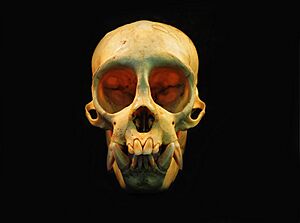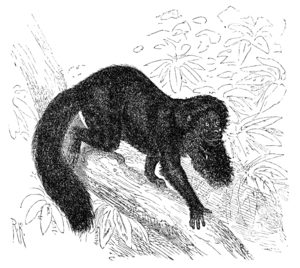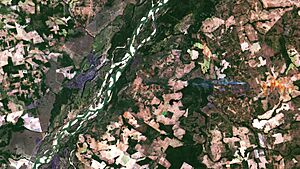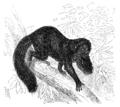Black bearded saki facts for kids
Quick facts for kids Black bearded saki |
|
|---|---|
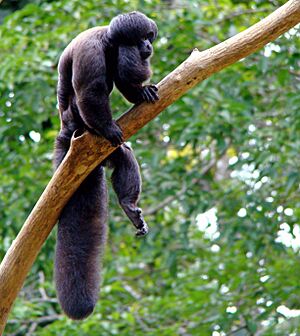 |
|
| Conservation status | |
| Scientific classification | |
| Genus: |
Chiropotes
|
| Species: |
satanas
|
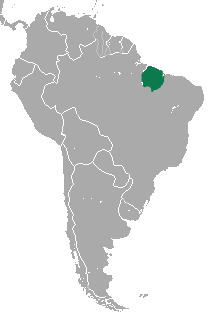 |
|
| Black bearded saki range | |
The black bearded saki (Chiropotes satanas) is a type of New World monkey. It lives in the Amazon rainforest in north-eastern Brazil, in South America. This monkey is one of five kinds of bearded saki.
Bearded sakis are medium-sized, about 50 cm long. They mostly eat fruit, especially seeds. Their scientific name, Chiropotes, means "hand-drinker". They use their hands like a spoon to drink water. This might help keep their unique beards clean and neat. Sadly, their home is shrinking, which makes their future uncertain.
Contents
Where Do Black Bearded Sakis Live?
Black bearded sakis live only in the eastern Amazon rainforest in Brazil. Their home is a small area between the Tocantins River and the Grajaú River. They are the only Amazonian pitheciid monkey found east of the Tocantins River.
A group of bearded sakis usually lives in an area of 200 to 250 hectares. Studies show these monkeys can sometimes adjust if their habitat gets smaller.
What Do Black Bearded Sakis Look Like?
Black bearded sakis have thick black fur. They have a special beard that frames their face. Their tail is bushy, like a fox's tail, and they cannot use it to grab things.
They move around on all four limbs, like a dog. Some black bearded sakis have yellowish-brown fur on their back and shoulders. They weigh between 2 kg and 4 kg.
Male sakis are a bit bigger than females. Males also have a noticeable bulging forehead. Other types of bearded sakis, like the red-backed or brown-backed, used to be thought of as the same species. But now, scientists know they are different species based on their fur and DNA.
The black bearded saki is the only one with a dark nose and a blackish back. However, some females and young sakis might have a lighter, brownish back. Their teeth are very strong and are perfect for cracking open hard seeds. They can open very tough fruit pods to get to the seeds inside.
How Do Black Bearded Sakis Behave?
What Do Black Bearded Sakis Eat?
Black bearded sakis love to eat fruit. About 90% of their diet comes from fruits and seeds. They are especially good at eating seeds. They mostly eat plants from certain families, but they can eat over 100 different kinds of plants. This means they can change their diet if needed.
They also eat some fleshy fruits and small insects. Black bearded sakis use their strong canine teeth to crack open hard shells of fruits and nuts. This helps them get to the unripe seeds inside.
How Do Black Bearded Sakis Live Together?
These monkeys are very social animals. They often groom each other and play together. Sometimes, they even play with other types of monkeys.
Black bearded sakis live in groups called troops, with 20 to 30 monkeys. Members of a troop might split up and rejoin throughout the day. They travel long distances daily and use large areas as their home.
How Do Black Bearded Sakis Move?
Black bearded sakis spend most of their time resting, traveling, and eating. They usually move on all fours when they are in the trees. Baby monkeys can use their tails to grab things, but they lose this ability as they grow up.
How Do Black Bearded Sakis Reproduce?
Female bearded sakis are pregnant for about 5 months. They usually have one baby at a time. They become old enough to have babies when they are 4 years old. Black bearded sakis can live for about 18 years. They give birth to a new baby every two years.
Why Are Black Bearded Sakis Endangered?
Black bearded sakis are a critically endangered species. This means they are at a very high risk of disappearing forever. In recent years, cities have grown in the Brazilian Amazon. This has led to more roads, farms, and dams.
These changes break up the monkeys' home into smaller pieces. This is called habitat fragmentation. It also destroys their habitat and increases poaching, which is illegal hunting. As more people move into the Amazon, more land is cleared for farming. This causes more deforestation, which means cutting down forests.
How Does Forest Loss Affect Their Behavior?
Studies show that black bearded sakis can adapt to habitats that are much smaller than their original home. However, it's not clear if this helps them survive in the long run. When their forest home is broken up, their behavior changes.
Groups of sakis in small, isolated forest patches might not leave unless a "bridge" of new forest grows. These groups also tend to move and make less noise. They rest more often. When their habitat shrinks, more monkeys live in a smaller area. This can lead to more diseases spreading among them.
Black bearded sakis are also hunted for their meat. Their tails are sometimes used as dusters.
What Do They Eat When Their Home Shrinks?
Monkeys living in small forest pieces have fewer food choices. This is because there are fewer plant species available. So, they might eat plants that sakis in large, healthy forests would not usually touch. If logging removes the plants they usually eat, their diet changes.
Being able to eat different kinds of seeds and unripe fruits helps them survive in smaller forest pieces. But these conditions are not good for them unless the small forest pieces can connect to larger, healthy forests.
What Is Their Future?
Scientists have studied how black bearded sakis change their behavior when their home is broken up. In one study, groups of sakis living in small, isolated forest pieces (about 10 hectares) did not have babies for 3.5 years. This might be because there wasn't enough food or other resources in these small areas.
Smaller forest pieces also mean more monkeys live in a smaller space. This higher number of monkeys in one area can affect their health. Groups living in these smaller pieces are more likely to get parasites and diseases. It is not known if these monkeys can have healthy babies and populations in the small, broken-up forests they are forced to live in.
Protecting their habitat is the most important thing for their survival. The black bearded saki is considered the most endangered monkey in the Amazon. It has already disappeared from many parts of its original home.
Images for kids



